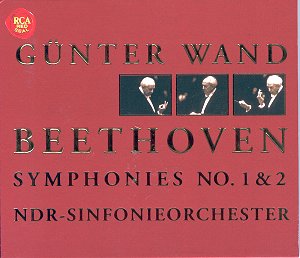Ludwig van BEETHOVEN
(1770-1827)
Symphony No. 1 in C major, Opus 21
Symphony No. 2 in D major, Opus
36
 North German Radio
Symphony Orchestra/Günter Wand
North German Radio
Symphony Orchestra/Günter Wand
Rec Dec 1997 (No. 1), Feb 1999, Musikhalle,
Hamburg
 RCA Red Seal
74321 66458 2
[59.04]
RCA Red Seal
74321 66458 2
[59.04]
Crotchet
AmazonUK
AmazonUS
Amazon
recommendations

Günter Wand, now in his eighties, is a conductor who is very much associated
with the German classics, and these live recordings from Hamburg follow his
previous Beethoven symphony performances on disc by ten years. The whole
cycle of nine symphonies was recorded with this same orchestra - the North
German Radio Symphony Orchestra - though the couplings were different. These
earlier performances are still available at mid-price.
The best description of the First Symphony is surely that of Donald
Tovey: 'a fitting farewell to the eighteenth century.' Beethoven was by 1800
an established figure in Viennese musical life, and he could confidently
look to the future. His developing deafness had yet to overwhelm him, and
therefore it is appropriate to judge this work as one which anticipates later
masterpieces, while at the same time acknowledging its debt to tradition.
These things are well captured in this new live recording, which benefits
from the excellent acoustic of the Musikhalle in Hamburg. In fact it is in
this regard that the clearest improvement on the previous recordings can
be discerned, since the point applies equally to the Symphony No. 2.
In both works the orchestral playing is exemplary, and there is a real sense
of a special occasion: the return of a former principal conductor, a revered
figure. As for the interpretations, its hard to find much that is different,
and those who already have the previous issues will gain slightly better
sound, but no more than that.
Tempi and balances are particularly well judged, and the music communicates
its special qualities with a natural sense of flow. In Symphony No. 2
there is also an appropriate sense of power as the faster music builds
in momentum. Although Wand is clearly an elder statesman of the musical world,
there is nothing stately about his performances. The music is just as dynamic,
just as lively, as Beethoven's earlier style demands. The mastery of transition
is among his strengths as a conductor; listen, for example, to the relationships
between slow introductions and succeeding Allegros, in the first movement
of the Second Symphony, but also in the first movement and finale of the
Symphony No. 1.
The catalogue contains sharper-edged performances of this repertoire, notably
from period instrument ensembles, but for spontaneous, stylish music making
with top class playing this is hard to beat.
Terry Barfoot
http://www.click2classics.co.uk

